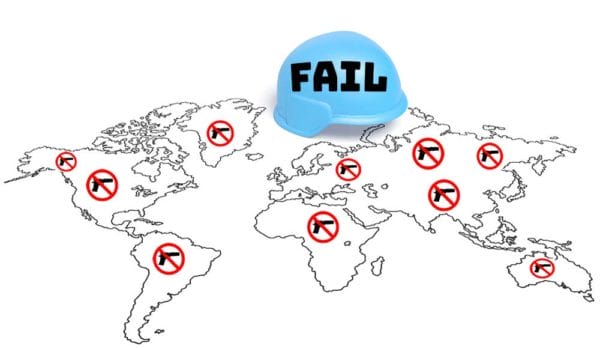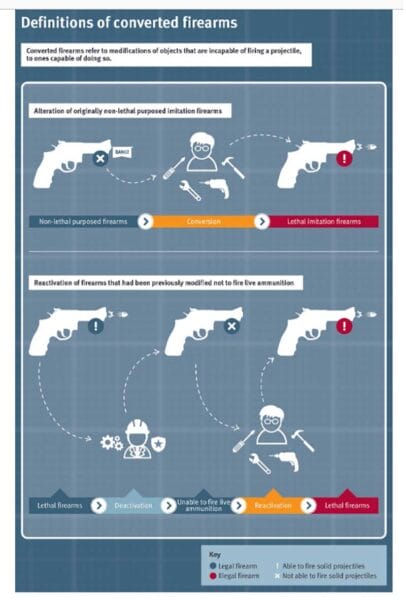Opinion by Gary Mauser, Alan J. Chwick, & Joanne D. Eisen
-
Critique of Global Firearms Control: Global firearms control policies fail to address the root causes of weapons proliferation and incentivize ingenuity among those seeking weapons.
-
Challenges in Controlling Homemade and Converted Firearms: The ease of manufacturing homemade firearms and converting non-lethal objects into deadly weapons poses significant challenges for law enforcement despite strict gun regulations in some regions.
-
Ethical Dilemmas in Japan: The ethical dilemmas surrounding firearms control in Japan, particularly in response to assassination attempts on Prime Ministers, raise concerns about governmental intervention in religious affairs.

Prime Minister (PM) Shinzo Abe was shot in the heart with a gun in Nara, Japan, on July 8, 2022. His shooting shocked the Japanese.
Guns in Japan are extremely hard to acquire. But, with ingenuity, firearms are easily made. Necessity is the mother of invention. Even in Japan. And making a firearm only requires a tube, some gunpowder, a projectile, and, of course, a touch of ingenuity.
Tetsuya Yamagami, Abe’s ingenious assassin, made and used an electrically-triggered double-barreled muzzleloader to kill the Prime Minister. When they searched Yamagami’s home, the Police discovered 6 other homemade weapons and over 4 pounds of gunpowder.
The use of a firearm to kill PM Abe bred hysteria among the Japanese elite. Politicians fear vengeful citizens. If one clever person with a grudge could so easily make a lethal weapon, then other individuals could make deadly devices as well.
Such thoughts drive firearms prohibitionists bonkers when they are forced to consider armed yet peaceful civilians.
Yamagami’s “craft gun,” as the U.N. calls it, and its parts were unregistered and unknown to the Japanese government. Global peace advocates and governments of the world crave total knowledge of all weapons, from their manufacture to destruction, which they vainly hope will allow them to stop all such violence. But that’s not to be. In 2018, with an estimated 857 million firearms owned globally by civilians, according to firearms researcher Aaron Karp, only about 100 million of those guns were registered. And “craft guns represent a major source of uncertainty.” They are also known as homemade weapons, artisanal weapons, improvised weapons, and ghost guns.
“Challenge”, And Secret Markets
Global firearms control analysts do not admit outright failure of their prohibitionist policies, so they hide behind weasel words like “challenge” instead of admitting failure. Challenge is a word that often sneaks into their reports, as it hints at the truth but cannot cover up the failure of the UN’s weapons control policy.
Prohibitionists appear unable to understand that the needs of mankind require markets. Because of the abusive presence of governments, mankind creates hidden or “underground” markets, a.k.a. “black markets,” aided by ever-present corrupt officials. Because black markets are hidden from governments, they will continue to prevent global weapons controllers from getting their wishes in the future, particularly because that future includes clever, ingenious humans. Even though civilians in a variety of countries have agreed to disarm, there is precious little to show that the UN’s arms control policies can prevent the diversion of firearms to anyone who chooses to own a weapon.
Governments are on the wrong path. The United Nation’s attempt to control weapons only incentivizes the ingenuity of those who want them. Governments need to pay attention to why citizens might legitimately want weapons. Gun control advocates studiously ignore the demand side. Understandably, citizens demand weapons to protect themselves and their families. No country is free from criminal violence, so the need for weapons is natural.
A little bit of rational thought and some knowledge of prior attempts to control weapons shows the vain futility of the prohibitionists’ wishful thinking. When humans are involved, there must be more to weapons control than laws based on false promises of safety and/or demands by untrustworthy governments. People need to feel secure in their homes and comfortable with their government’s commitments to protect their human rights.
The Rightful Proliferating of Craft Guns
Commenting on the events in Japan 3 months later in October, Matilde Vecchioni, an author and associate researcher for the United Nations Institute for Disarmament Research (UNIDIR), noted that information about constructing craft weapons was easily transmitted by modern media platforms and that new, simpler technologies were rapidly evolving. She suspected that the violence against PM Abe with an improvised weapon “is only the tip of a widespread and overlooked phenomenon…”
Such easily made, unmarked, hard-to-trace guns, she explained, posed a serious threat, “With erroneous or absent serial numbers, or a lack of other markings, craft-produced weapons pose a notable challenge for law enforcement agencies seeking to determine the origin of and disrupt illicit production and trafficking networks.” Note that she used the word “challenge,” indirectly admitting previous failures, and, she hoped, covering up the future failures she anticipates.
A more recent Briefing Paper in November 2023 by Small Arms Survey researchers Julien Joly and Aline Shaban destroys the expectation of a quick fix. Between Tradition and the Law: Artisanal Firearm Production in West Africa examines the difficulties of controlling craft weapons, or any weapons, or even any goods or services, by attempting to uniquely control the supply side.
Difficulties controlling commercially manufactured weapons that are properly marked and identified pale in contrast to difficulties of controlling unmarked “artisanal” weapons. Joly and Shaban term this lack of marking on craft guns as “regulation avoidance among craft producers,” many of whom are illiterate. The authors note that despite many gun control initiatives and protocols in West Africa, “the number of arms in circulation… remains high.” And they also note the presence of “high corruption levels.” That phrase indicates that the authors are aware of the presence of those pesky hidden markets.
For example, acquiring ammunition for these weapons is as easy as making or buying the gun they fit. Although most Economic Community Of West African States (ECOWAS) countries ban illicit manufacturing of ammunition, both industrial ammunition and reloaded rounds are somehow always available and, according to Joly and Shaban, even primers are easily obtained from the local black market. Regardless of the law, there is no shortage of weapons or ammunition.
Although the actual goal is to prohibit rather than regulate, Joly and Shaban offer a compromise. “Experience… suggests that regulating – rather than prohibiting – the production of craft firearms is more conducive to achieving the right balance…”
So, after admitting that prohibition has failed, they still believe that weapons may ultimately be prohibited if at first they first focus on introducing the proper regulations.
Joly and Shaban admit, “Regulating craft production in the region has proven particularly challenging.” There’s the word ‘challenging’ again.
The UN is also concerned about diversions of industrially produced weapons. A recent January 2024 Briefing Paper from Small Arms Survey by Holger Anders, did not refer to home-made craft weapons, but to diverted industrially produced weapons in Mali, one of the ECOWAS countries. Holger describes a litany of acquisitions and diversions of weapons and ammunition to various dissident armed groups despite a decade of UN peacekeeping presence. Holger does not deal with the poor governance issues in Mali and he goes right to the heart of his topic by admitting, “The enduring extremist ability to obtain arms, ammunition, and explosives does not bode well for the prospects of greater stability in Mali.”
Finally, Holger, referring to the proliferation of illicit trafficking and citing the December 31 withdrawal of U.N. Peacekeepers concludes, “The recent withdrawal of the United Nations Multidimensional Integrated Stabilization Mission in Mali, a.k.a. MINUSMA, and international peacekeeping forces will make the challenge all the greater.”
Converted Weapons


Another class of firearm that sparks anxiety through the ranks of elitist firearms controllers, and shows the cleverness of mankind when confronted with the law, is the “Converted Weapon.” As Nicolas Florquin and Benjamin King, portray the situation, it is not a West African lack of success, but a European comedy of failure.
Converted weapons, as defined by the authors, refer to the “modification of objects that are incapable of firing a projectile, to ones capable of doing so.” It also refers to the “reactivation of firearms that had been previously modified not to fire live ammunition.” As with homemade guns, the authors agree that the conversion of weapons is “without the need for specialized skills or equipment.” And again, as with homemade guns, online information aids “ingenious, self-trained individuals with no particular prior expertise” in the conversion of safe objects into deadly weapons.
When there is an unmet demand for such a modifiable “object,” folks almost always find a way to obtain it. Florquin and King admit, “the phenomenon is more visible in countries with the strictest gun laws,” where guns are most difficult to get. And this “firearms conversion threat” cannot be enumerated, as the authors complain, “Measuring the true scale of the availability of readily converted firearms is challenging.” Not only do the authors rely upon the misleading term “challenging,” but they also invented a new term, “ant trafficking,” which is intended to describe the shipment of small amounts of illegal weapons into and within Europe, making them more difficult to control.
Florquin and King describe “alarm guns” as capable of firing blanks, irritants, and signaling ammunition, but not solid projectiles. They discuss the existence of a Turkish “alarm gun,” the Ekol Tuna, to describe what we American gun owners would consider a joke. The authors explain, “For the version that is easiest to convert, one can simply unscrew the barrel obstruction with a common screwdriver. This is particularly problematic for law enforcement because the same obstruction can be reinserted into the barrel, thus hiding its conversion.” Yes, this situation is a problem, but why does such a problem exist?
Live Inventory Price Checker
|
|
A |
A |
$ A |
Yet again, we can see the failure of present policy and law to control weapons proliferation among terrorists, criminals, and, yes, even the folks who want a gun for self-defense. The authors have many complaints about human behavior and ingenuity, “As new regulations are enacted, new types of firearms conversions appear.” No matter what actions governments take, manufactured firearms, homemade firearms, and converted firearms remain largely out of the control of governments, yet easily available to those who want one. Policymakers are unable “to curtail the demand,” and so the supply side governs the situation.
What about the availability of ammunition in the European Union? A recent report, Illicit Firearms Ammunition and Other Explosive Munitions in the European Union, published in December 2023, “illustrates the challenges associated with documenting and tracing the origins of illicit firearms ammunition,” partly because of the lack of “unique identifying marks on individual cartridges.” The EU ignores the fact that there are too many technical issues associated with marking every cartridge, even with factory-made ammunition.
So the authors suggest establishing a “global framework” that “may provide momentum for more systematic marking practices in the future.” Apparently, ammunition markets are not only present and active in Mali, but also in the better-organized European Union. Criminals can get ammunition at will. These prohibitionists are not asking for failure, they are demanding failure. Oops, that is, they are seeking out more ‘challenges.’
Back To Japan
Meanwhile, in Japan, the assassination of PM Abe exposed the reasons Japanese elites insist on strict firearms control. The assassin’s sad personal history generated a great deal of sympathy. The public understood why an angry guy killed a politician who aided a religious group that had bankrupted his mother. Who could blame him when the politician’s security even allowed the killer to get too close?
What would you do? Tighten the gun laws? Increase security for politicians while they lie to constituents? Or ban the religious group? These scandalous policies can be used lawfully in Japan to justify whatever the political class wants, even the dissolution of the suspect religion.
Then it happened again. Mari Yamaguchi reported in her article Explosive Targeting Japan PM Renews Worry of Homemade Arms in April 2023, that Ryuji Kimura made a pipe bomb and threw it at Prime Minister Fumio Kishida during a campaign event. Kishida survived the attack, and the Japanese government was forced to make a decision and act.
In October 2023, Japan asked for a court order to dissolve the Unification Church, known as the Family Federation for World Peace and Unification, whose financial greed had drained assassin Yamagami’s family of resources needed to provide a nurturing childhood. The chief of the legal affairs department, Nobuo Okamura, said that “it was a serious threat to religious freedom and the human rights of its followers.” As Americans, we can see that Japan had no choice, and we do not like any future in which our country could be forced into the decision that Japan made.
Finally, in January 2024, a ministerial-level panel met to discuss support measures for other victims, such as job search aid, and school counseling, even as the Church assets were frozen, and connections to the Church by government officials began to surface.
With the trial expected to be scheduled for later this year, the world will find out that parents sometimes fail to raise their children successfully, and the global weapons control folks will be reminded that gun control is always going to be “challenging,” in West Africa, the European Union, and especially Japan.
The UN cannot stop citizens from arming themselves for protection. Human nature includes a large dollop of ingenuity, and ingenuity can transform necessity into success: necessity is the mother of invention.
Read Related:
Small Arms Survey From Legal to Lethal Converted Firearms in Europe Report 2018
About The Authors
Gary Mauser is a professor emeritus at Simon Fraser University in British Columbia, Canada. Check out his blog at JusticeForGunowners.ca for more information.
Alan J. Chwick has been involved with firearms much of his life and is the Retired Managing Coach of the Freeport NY Junior Marksmanship Club. He has escaped New York State to South Carolina and is an SC FFL (Everything22andMore.com). [email protected] | TWITTER: @iNCNF
Joanne D. Eisen, DDS (Ret.) practiced dentistry on Long Island, NY. She has collaborated and written on firearm politics for the past 40+ years. She, too, escaped New York State, but to Virginia. [email protected]





